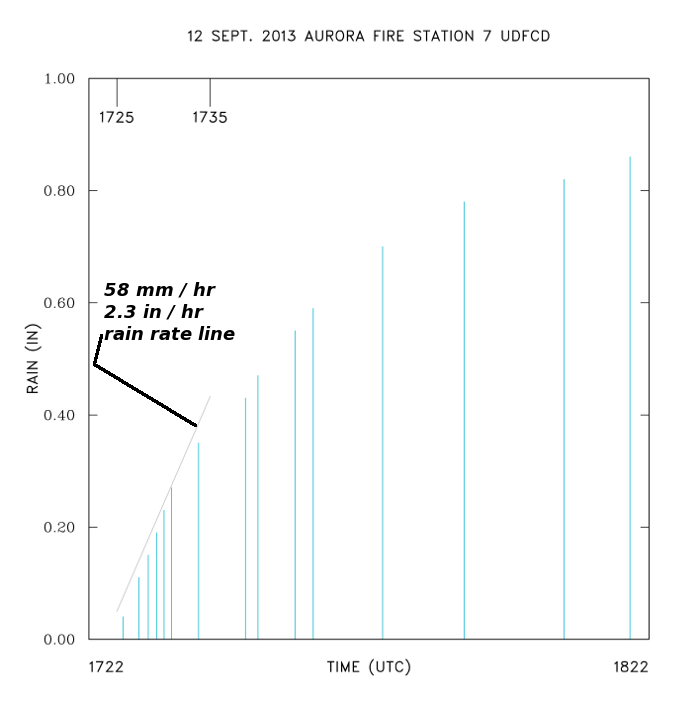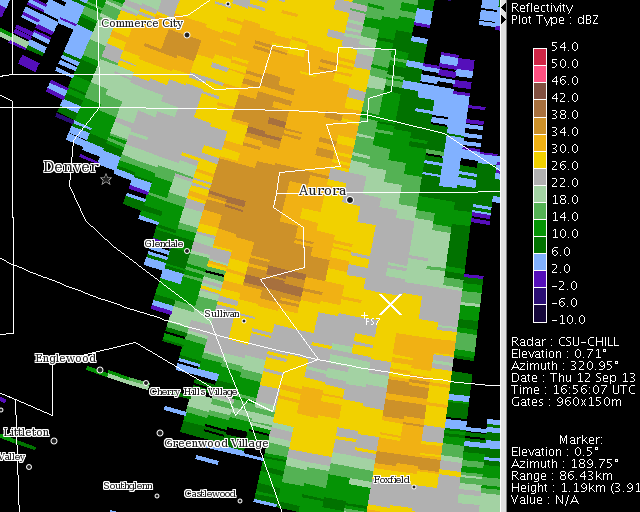Initial plots from flooding rainfall in Aurora, Colorado: 13 September 2013: Difference between revisions
Pat kennedy (talk | contribs) No edit summary |
Pat kennedy (talk | contribs) No edit summary |
||
| Line 1: | Line 1: | ||
[[Image:12sept2013 1723 VCHILL z.png|center]] | |||
==Overview== | |||
Between the evening hours of Wednesday, 11 September 2013 and mid-day on Friday, 13 September 2013 significant flash flooding occurred on many drainages from the Denver area northward through Larimer County. CSU-CHILL radar observations of this event started around 1530 UTC / 0930 MDT on Thursday, the 12th. The full radar data set contains a considerable amount of data. This article only considers a one hour time period (1722 - 1822 UTC on 12 September) when moderate reflectivity, relatively low Zdr "tropical rain" showers were contributing to flooding near Aurora, Colorado. | |||
==Reflectivity loop== | |||
The following loop was assembled from 0.5 degree elevation angle PPI scans that were conducted at slightly over 3 minute time intervals. Higher intensity echoes repeatedly moved across the eastern Denver / Aurora areas. | |||
<center> | <center> | ||
<imgloop delay=200 imgprefix="http://www.chill.colostate.edu/anim/12sept2013_FS7_loop/" width=640 height=512> | <imgloop delay=200 imgprefix="http://www.chill.colostate.edu/anim/12sept2013_FS7_loop/" width=640 height=512> | ||
| Line 41: | Line 48: | ||
</center> | </center> | ||
==Differential reflectivity== | |||
The following VCHILL image shows the S-band differential reflectivity at 1722 UTC. The low (generally less than 1.5 dB) maximum Zdr values shown in this sweep were typical of the values observed throughout the day. The low Zdr magnitudes indicate that the median diameter of the rain drop distribution was small (on the order of 2 mm diameter or less). | |||
[[Image:12sept2013 1723 VCHILL zdr.png|center]] | |||
==XYE grid data plots== | |||
To generate contour plots, the data in the 1722 UTC 0.5 deg elevation angle PPI sweep were interpolated to a 500 m X, Y grid point array using the NCAR SPRINT program. The following plot shows the S-band reflectivity field. The point marked "FS" is the location of the Denver Urban Drainage and Flood Control District ALERT network tipping bucket rain gauge located at Aurora Fire Station #7. | |||
[[Image:S band XYE z.png|center]] | [[Image:S band XYE z.png|center]] | ||
The following plot shows the corresponding S-Band specific propagation differential phase (Kdp) field. Values in the vicinity of Fire Station #7 were less than 1 deg / km. | |||
[[Image:S band XYE kdp.png|center]] | [[Image:S band XYE kdp.png|center]] | ||
The Kdp field observed at X-band (9 GHz) in the same PPI sweep is shown below. Due to the greater differential phase shift response at the shorter wavelength, Kdp magnitudes of ~2 deg / km were observed near the Fire Station. The cause of the spatial displacement between the S and X-band Kdp maxima has not yet been determined. | |||
[[Image:X band XYE kdp.png|center]] | [[Image:X band XYE kdp.png|center]] | ||
==Tipping bucket record from the Aurora Fire Station 7 gauge== | |||
The vertical blue lines in the following plot show the time of the individual bucket tips at Fire House 7; closer horizontal spacings between the lines signify higher rain fall rates. As shown by the grey line, the observed rain fall rate in the 1725 - 1735 UTC period was approximately 58 mm / hr. | |||
[[Image:FS7 trace.png|center]] | [[Image:FS7 trace.png|center]] | ||
Revision as of 16:28, 30 September 2013

Overview
Between the evening hours of Wednesday, 11 September 2013 and mid-day on Friday, 13 September 2013 significant flash flooding occurred on many drainages from the Denver area northward through Larimer County. CSU-CHILL radar observations of this event started around 1530 UTC / 0930 MDT on Thursday, the 12th. The full radar data set contains a considerable amount of data. This article only considers a one hour time period (1722 - 1822 UTC on 12 September) when moderate reflectivity, relatively low Zdr "tropical rain" showers were contributing to flooding near Aurora, Colorado.
Reflectivity loop
The following loop was assembled from 0.5 degree elevation angle PPI scans that were conducted at slightly over 3 minute time intervals. Higher intensity echoes repeatedly moved across the eastern Denver / Aurora areas.
|
|
||
|
Differential reflectivity
The following VCHILL image shows the S-band differential reflectivity at 1722 UTC. The low (generally less than 1.5 dB) maximum Zdr values shown in this sweep were typical of the values observed throughout the day. The low Zdr magnitudes indicate that the median diameter of the rain drop distribution was small (on the order of 2 mm diameter or less).
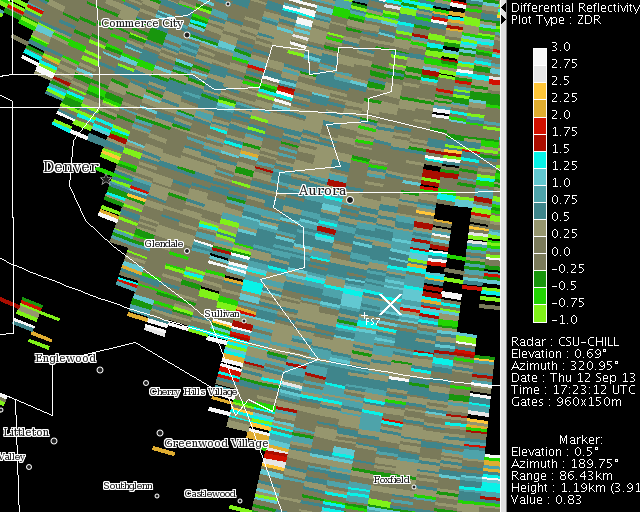
XYE grid data plots
To generate contour plots, the data in the 1722 UTC 0.5 deg elevation angle PPI sweep were interpolated to a 500 m X, Y grid point array using the NCAR SPRINT program. The following plot shows the S-band reflectivity field. The point marked "FS" is the location of the Denver Urban Drainage and Flood Control District ALERT network tipping bucket rain gauge located at Aurora Fire Station #7.
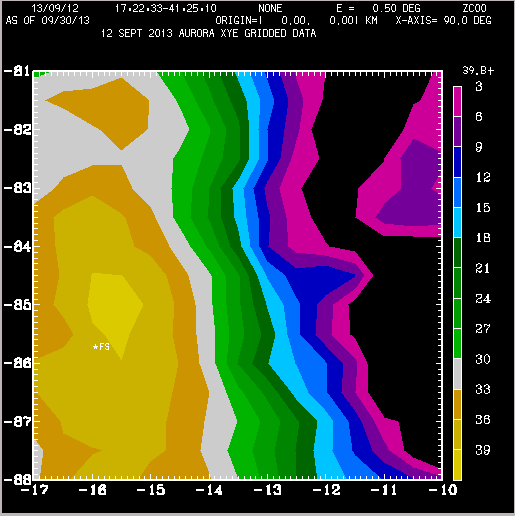
The following plot shows the corresponding S-Band specific propagation differential phase (Kdp) field. Values in the vicinity of Fire Station #7 were less than 1 deg / km.
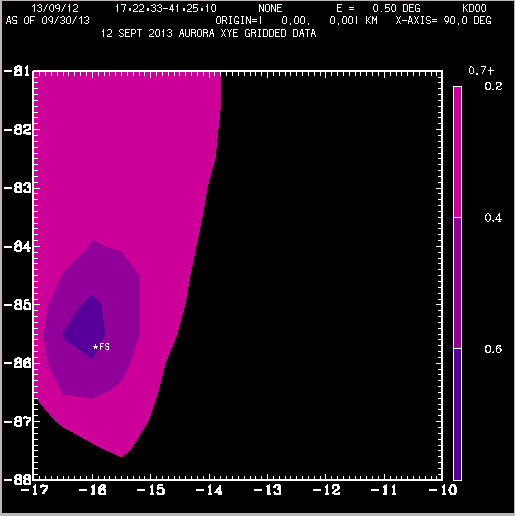
The Kdp field observed at X-band (9 GHz) in the same PPI sweep is shown below. Due to the greater differential phase shift response at the shorter wavelength, Kdp magnitudes of ~2 deg / km were observed near the Fire Station. The cause of the spatial displacement between the S and X-band Kdp maxima has not yet been determined.
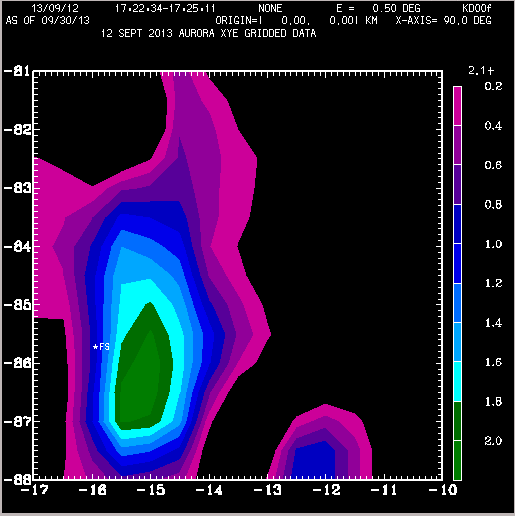
Tipping bucket record from the Aurora Fire Station 7 gauge
The vertical blue lines in the following plot show the time of the individual bucket tips at Fire House 7; closer horizontal spacings between the lines signify higher rain fall rates. As shown by the grey line, the observed rain fall rate in the 1725 - 1735 UTC period was approximately 58 mm / hr.
